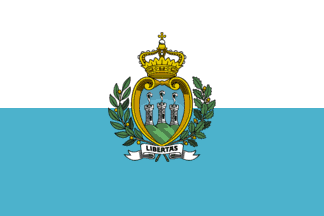 (2:3)
(2:3)  image by M. Schmöger, 9 August 2011
image by M. Schmöger, 9 August 2011
Last modified: 2021-05-15 by rob raeside
Keywords: san marino | europe |
Links: FOTW homepage |
search |
disclaimer and copyright |
write us |
mirrors
 (2:3)
(2:3)  image by M. Schmöger, 9 August 2011
image by M. Schmöger, 9 August 2011
Official Name: Republic of San Marino
(Repubblica di San Marino)
Capital: San Marino
Location: Southern Europe - Enclave in Central
Italy
Government Type: Republic
Flag adopted: 6
April 1862
ISO Code: SM
See also:
I got the my following queries about San Marino:
-According to some Internet-sources the official designation of
San Marino between 301 and 1243 was successively "Land of
San Marino" and "free City of San
Marino". Can you give me the long-form names in local
language and the exact dates/years of the use of these names?
- After 1243 San Marino was officially styled as: "Most
Serene Republic of San Marino", according to most historical
documents (for instance: de Political Handbook of the
World). But the coins of San Marino just mentioned
"Repubblica di San Marino". Does this mean, that
both names are equally used as official names for the polity. Or
does it means that "Repubblica di San Marino" was used
later on (can you give me the exact date) besides or in
stead of the "Most Serene Rep. of San Marino". Or was
the term used only in semi-official usage?
- Did the formal names and the styles of San Marino
change (for instance: duchy or county) during the following
foreign occupations:
-1503 Ceasar Borgia
-1739/40 Papal State
-1944 Germany
-1944 Britain and USA
Henk Meyer, 27 December 2000
Land of San Marino: Terra di San Marino.
Free City of San Marino: Cittá Libera di San Marino.
I think that the "Most Serene Republic of San Marino"
is just a grand title. As far as I know, San Marino has always
been Republic of San Marino, at least since 1815.
Gerhard Eger, 8 January 2003
The actual denomination is "Serenissima Repubblica di San
Marino", where "Serenissima" is the Italian for
"The most serene" (better, in this case it means
"The very serene"); the adjective has been
historically used for the Republic of Venice, in facts "La
Serenissima" in Italy is used to indicate Venice or its old
Republic.
Alberto Fiorentini, 12 May 2003
No official shades have been issued with regard to either the
stripes or the arms, and no recommendations for the arms are
given in any official source. However, the UK Flag
Institute give Process Blue, BR20 PMS 549 and the Album des
Pavillons PMS 292C for the stripe.
Christopher Southworth, 4 March 2005
As stated in W. Smith's "F&AATW" by government
and army forces is used the white-blue flag with state's coat of
arms. As I read the signs there is a few variants of the
appearance of the arms. Also it is stated that the flag is a 'de
facto' flag, used without the legal background.
Željko Heimer, 10 November 1995
The Law on the flag can be found at http://www.consigliograndeegenerale.sm/on-line/Home/LavoriConsiliari/Dettaglidelleconvocazioni/documento17044527.html
Translated:
REPUBLIC OF SAN MARINO
We, the Captains Regent the Most
Serene Republic of San Marino
According to art. 4 of the Constitutional
Law no. 185/2005 and art. 6 of the Organic Law no. 186/2005; we promulgate and
mandate the publication of the following Constitutional Law approved by the
Great and General Council during its session of 20 July 2011 with 45 votes in
favour, 2 votes against and 1 abstention:
CONSTITUTIONAL LAW 22 July 2011
No. 1
FLAG AND OFFICIAL ARMS OF THE REPUBLIC OF SAN MARINO INTEGRATION
INTO THE LAW OF 8 JULY 1974 NO. 59
Art. 1
To the Law of 8 July 1974
no. 59 the following article is added:
“Art. 2a (flag and arms)
The
flag of the Republic of San Marino consists of two fields, divided horizontally,
the upper one white, the lower one light blue, in the center showing the
official arms. The official arms of the Republic is surmounted by a closed
crown, symbol of sovereignty. The shield is Azure with three mountains Vert,
three towers Argent, windowed, embattled and masoned Sable, topped by ostrich
plumes Argent. The shield is decorated by two branches Vert, crossed in saltire
under the shield, the one of laurel, the other of oak, fructed Or. On a ribbon
Argent the motto LIBERTAS in capitals Sable.”
Art. 2
(flag)
The
flag of the Republic of San Marino is defined by the graphical model that forms
the appendix A of the present law.
Art.3
(official arms)
The
official arms of the Republic of San Marino is defined by the graphical model
that forms the appendix B of the present law.
Art. 4
(Provisos)
The
usage of the official arms is regulated by ordinary law. The regulation of the
usage of the flag is assigned to executive order.
Art. 5
(Entry in
force)
The present law comes into force the 15th day following its legal
publication.
Given at Our Residence, on 22 July 2011/1710 since the
foundation of the Republic
THE CAPTAINS REGENT
Maria Luisa Berti –
Filippo Tamagnini
THE SECRETARY OF STATE FOR INTERNAL AFFAIRS
Valeria
Ciavatta
-------------
Appendix A - Official flag of the Republic
of San Marino
Proportions of the flag: 3:4
Dimensions of the arms on
the flag width of the arms 3/2 L
Position of the arms on the flag
horizontally: the arms are centered along the length of the flag vertically: the
intersection of the arms of the cross on the crown is 1/2 L from the upper edge
The official flag can assume the proportion 2:3 for international uses
and/or when specifically envisaged. At a proportion of 2:3 the arms will occupy
the central third of the length and the line that passes through the
intersection of the arms of the cross of the crown will be at 1/6 of the height
from the upper edge.
| Name | Pantone Coated | Pantone Uncoated | CMYK | Pantone TPX |
| Celeste | 2915 C | 2915 U | 55/10/5/0 | 14-0852 TPX |
| Flag white | Pure white | Pure white | 0/0/0/0 | 15-4323 TPX |
| Name | Pantone Coated | Pantone Uncoated | CMYK | Pantone TPX |
| sun yellow | 7406 C | 7404 U | 5/25/100/0 | 14-0852 TPX |
| golden yellow | 124 C | 7405 U | 5/35/100/10 | 15-1050 TPX |
| Brown of branches | 7559 C | 7558 U | 15/35/70/30 | 18-0939 TPX |
| Green in light | 576 C | 577 U | 47/10/70/0 | 17-0336 TPX |
| Green of foliage | 7742 C | 363 U | 65/25/80/13 | 18-0135 TPX |
| Green in shadow | Cool gray 4 C + 7742 C or 350 C | Cool gray 3 U + 363 U or 350 U | 65/25/80/50 | 14-4103 TPX + 18-0135 TPX or 19-6311 TPX |
| Sky blue | 291 C | 291 U | 47/8/7/0 | 14-4318 TPX |
| Shadow blue | Cool gray 4 C + 291 C or 7698 C | Cool gray 3 U +291 U or 7698 U | 70/30/20/20 | 14-4103 TPX + 14-4318 TPX or 18-4217 TPX |
| Shadow grey | Cool gray 4 C | Cool gray 3 U | 0/0/0/30 | 14-4103 TPX |
| Black | Black C | Black U | 0/0/0/100 | Black TPX |
M. Schmöger, 9 August 2011
 (3:4)
(3:4)  image by M. Schmöger, 9 August 2011
image by M. Schmöger, 9 August 2011
 (3:4)
(3:4)  image by Mark Sensen, 7 November 1995
image by Mark Sensen, 7 November 1995
According to Album 2000 [pay00]
- this is the alternative civil flag (C--/C-- (3:4)). Regarding
the civil flag (and ensign), has anyone ever seen a ship (boat,
yacht whatever) registered in San Marino? Was this flag confirmed
in use on sea in modern time?
Ivan Sache, 14 January 2001 and Željko Heimer,
2 January 2003
My name is Martin Grund from Germany. I am the initiator of
the world's first penguin webcam in the Antarctic. At the moment
there is a scientist from San Marino working in the German
Antarctic Research Station Bernado O'Higgins and you can see the
civil flag of San Marino in the photo of one of the station's
webcams. Here a photo from our archive at www.pinguincam-online.de
(no longer active).
Martin Grund, 29 November 2004
 image by Rick Wyatt, 6 September 1998
image by Rick Wyatt, 6 September 1998
The flag you mention has been reported as the Merchant Ensign
of San Marino by various sources (see National Geographic for
example). Unfortunately no evidence exists that this flag
actually existed. San Marino, for those who did not have a chance
to visit it, is on a mountain with no direct access to any sea,
even if the Adriatic Sea is close to it.
Pier Paolo Lugli, 6 April 1998
The October 1917 National Geographic [geo17] states: Figure 815: "The
merchant flag of San Marino, which, though that of a belligerent,
the little republic having dared to declare war against the
Central Powers, has probably never yet been encountered by a
German submarine because, as may well be imagined, the merchant
navy of the mountain republic is not large."
Nick Artimovich, 6 April 1998
The Declaration of Barcelona, 20th April 1921 recognised the
right of states with no littoral to fly their own flag at sea.
D. Prothero, 6 October 2000
.gif) (2:3)
(2:3)  image by M. Schmöger, 9 August 2011
image by M. Schmöger, 9 August 2011
Description
Description in Pedersen's "Moussault's Lexicon Vlaggen en
Wapens", 1980: "In its present the CoA dates from 6 Apr
1862. Even though San Marino was always a republic, it has a
crown on top of it as a sign of sovereignty. The three white
towers, crowned by a ostrich feather, remind of three castles on
three mountain tops of the Titano Mountains. The coat of arms dates at
least from the 14th century. Around is wreath of oak and laurel.
Motto: Libertas - Liberty."
Jarig Bakker, 3 January 2003
The Crown
Nathan Lamm asked: If it's a republic, why is there a
crown on the seal?
This is surely among the oldest republics to do so, but a number
of other republics in the region did (and some still do) the
same. The crown is here symbol of sovereignty and independence
rather then the hereditary monarchy. Some examples that come to
mind include Republic of Ragusa (Dubrovnik, on this side of
Adriatic), and in modern age both Austrian republic(s) and even
more modern Hungarian republic use crowns as symbols of
sovereignty. Poland comes to mind, too.
Željko Heimer, 3 January 2003
The Towers
Nathan Lamm asked: What are the smokestacks, if
that's what they are?
These are three towers, each with an ostrich feather on the top.
These picture the towers of the citadel of San Marino named
Guaita, Cesta and Montale. Each of the towers is, they say,
equipped with a metal wane at the top, that is in heraldic
interpretation pictured as feather. Compare, e.g. Smith 1982.
Željko Heimer, 3 January 2003
The Branches
Nathan Lamm asked: What are the two different
branches on the sides?
I guess that I can't be that wrong interpreting the branches as
laurel and oak. These are usually taken to symbolize glory and
(military) strength, and as such found in many Coat of Arms (cf.
Portuguese army emblem, Estonian greater arms etc.).
Željko Heimer, 3 January 2003